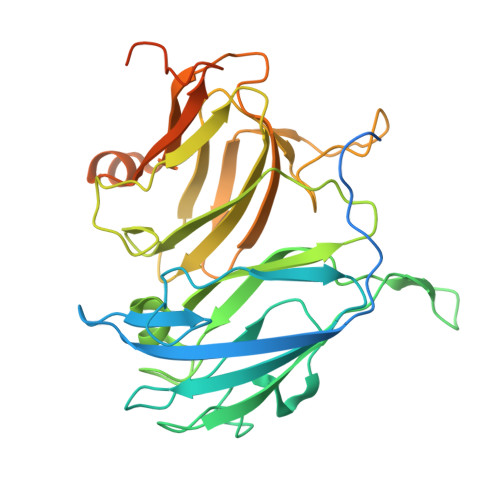Unexpected effect of an axial ligand mutation in the type 1 copper center in small laccase: structure-based analyses and engineering to increase reduction potential and activity.
Wang, J.X., Vilbert, A.C., Williams, L.H., Mirts, E.N., Cui, C., Lu, Y.(2025) Chem Sci 16: 11339-11346
- PubMed: 40438172
- DOI: https://doi.org/10.1039/d5sc02177d
- Primary Citation of Related Structures:
9NJI, 9NJJ - PubMed Abstract:
Type 1 copper (T1Cu) centers are crucial in biological electron transfer (ET) processes, exhibiting a wide range of reduction potentials to match their redox partners and optimize ET rates. While tuning in mononuclear T1Cu proteins like azurin has been successful, it is more difficult for multicopper oxidases. Specifically, while replacing axial methionine to leucine in azurin increased its by ∼100 mV, the corresponding M298L mutation in small laccase from Streptomyces coelicolor (SLAC) unexpectedly decreased its by 12 mV. X-ray crystallography revealed two axial water molecules in M298L-SLAC, leading to the decrease of due to decreased hydrophobicity. Structural alignment and molecular dynamics simulation indicated a key difference in T1Cu axial loop position, leading to the different outcome upon methionine to leucine mutation. Based on structural analyses, we introduced additional F195L and I200F mutations, leading to partial removal of axial waters, a 122-mV increase in , and a 7-fold increase in k cat / K M from M298L-SLAC. These findings highlight the complexity of tuning in multicopper oxidases and provide valuable insights into how structure-based protein engineering can contribute to the broader understanding of T1Cu center, and reactivity tuning for applications, such as in solar energy transfer, fuel cells, and bioremediation.
- Department of Chemistry, The University of Texas at Austin 105 East 24th Street Austin TX 78712 USA yi.lu@utexas.edu.
Organizational Affiliation:




















